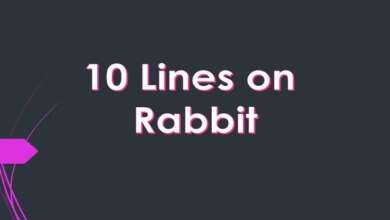10 Lines on Bear in English for Kids and Students
10 Lines on Bear
10 Lines on Bear: Bears are big animals that live in different parts of the world like forests and zoos. In the entire world, there are eight kinds of bears, like Black bears, polar bears, brown bears, panda bears, etc. They have strong teeth, long hair, and sharp nails, and they eat many kinds of food like bugs, plants, fish, and small animals as well. Bears are important for their place and have meaning in many groups of people. But many kinds of bears are in danger because they lose their home, people hunt them, and the weather changes. It is important to keep and protect their groups and homes for the future. Let us know 10 sentences on the bear.
Set (1) 10 Lines on Bear For Class 1, 2, 3, 4
1. Bears are big, nice animals.
2. Many types of bears can be seen around us, like polar bears, black bears, brown bears, and pandas.
3. Bears have sharp nails and strong teeth to help them get food.
4. They like to eat plants and animals.
5. Some bears live in cold places, like the North Pole, whereas others live in hot places.
6. We need to be careful and safe when we see a bear.
7. Bears help keep balance in their place and are important to other animals.
8. A young bear can go many miles.
9. Some bears are in danger because their homes and food are taken away.
10. We can help bears by keeping their homes and making them safe.
**********************************************
Set (2) 10 Lines on Bear For Class 5, 6, 7
1. Bears are big, nice, and strong animals that live in many parts of the world.
2. There are many types of bears around us, like polar bears, brown bears, and pandas.
3. Bears have sharp nails which help them to keep hair and food warm.
4. They eat both plants and animals, and they have a very good nose.
5. Some of them, like polar bears, live in cold places, whereas others live in hot places.
6. Bears can be bad for people, so it is important to be careful when we see them.
7. Bears play an important part in their place and help keep other animals under control.
8. Some groups of people see bears as special and strong animals and tell stories about them.
9. Sadly, some kinds of bears are at risk because people hunt them and they lose their natural homes.
10. We need to work to protect bears and their homes so they can keep living in our world.
*******************************************
Set (3) 10 Lines on Bear For Class 8, 9, 10
1. Bears are big, meat-eating animals that belong to the family Ursidae.
2. Around the world, there are eight kinds of bears we can see like polar bears, brown bears, and giant pandas.
3. Bears have long hair, sharp nails, and strong jaws and teeth that they use to hunt and look for food.
4. They are omnivorous and eat a many variety of foods like small animals, plants, fish, and bugs as well.
5. Bears are alone animals except for mothers with babies, and they have strong noses.
6. Some kinds of bears sleep during the winter, while others stay in a slow state.
7. Bears play an important part in their place, moving seeds around and helping to keep balance in the food chain.
8. Bears have meaning in many groups of people and are often shown in stories and old tales.
9. Sadly, many kinds of bears are at risk because they lose their home, people hunt them, and the weather changes.
10. To make sure the future of bears for future people, it is important to protect and keep bear groups and their homes.
********************************************
Read also –
Q&A. on Bear
Where have you found the bears?
Answer – Bears can be seen mainly in North America, Europe, and Asia and include European brown bear, Carpathian bear, Gobi bear, brown bear, Kodiak bear, and many other subspecies.
What is the eating habit of bears?
Answer – Bears are omnivores. Its diet consists of fish, berries, grains, birds, insects, and mammals. However, the majority of a bear’s diet, about 70%, consists of a diet other than meat.
How do bears travel?
Answer – Bears generally avoid highways and high-traffic areas, a young bear may travel hundreds of miles when they separate from its mother to establish its own home range.




